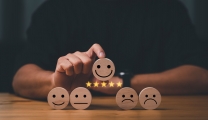What is Brand Salience?
The term “brand salience” refers to a key performance indicator that shows how readily consumers think about or otherwise consider your brand when making a related purchase decision.
Do they picture you, or does it seem more natural to buy from one of the other guys?
High brand salience means people instinctively think of your products when they’re in the market for something similar.
Low brand salience, on the other hand, can mean people either don’t know of your brand or haven’t been exposed to it enough for purchasing from you to be second nature.
For example, what brand would immediately pop into your head if you needed to buy a box of tissues?
If you’re like most people, it’s Kleenex. And if you find yourself in the mood for an ice-cold cola to enjoy with your lunch, you probably instinctively think of either Coca-Cola or Pepsi.
If you’re looking for information online, you head immediately to Google for your answers.
In fact, the brand salience attached to products like those is so high, many people see those brand names as interchangeable with the products they represent. (Who hasn’t asked for a Kleenex before or said they’re going to Google something.)

It’s pretty much every marketer’s dream to achieve something similar with the brands they represent.
How Does Brand Salience Differ from Brand Awareness?
Although brand salience and brand awareness are related, it’s important to realize they’re not the same thing.
Brand awareness is all about how aware people are of your brand on a general level.
- Have they heard of you?
- Do they know off the tops of their heads what types of services or products you specialize in?
- Are people talking about you?
- How familiar are they with your brand imagery, core messages, and marketing concepts?
On the other hand, brand salience refers specifically to whether people are aware enough of your brand to immediately think of you when it’s time to make a purchase.
- Are you the Coca-Cola or Kleenex of your industry?
- How close is your brand to becoming the go-to “gold standard” for the types of items you offer?
How Do You Measure Brand Salience?
The concept of brand salience is somewhat abstract, so it can’t necessarily be measured with the same accuracy of more data-specific metrics.
The criteria that make a brand like Starbucks, Kleenex, Google, or Coca-Cola a household name for one person may not be the same for another person, and vice versa.
Ultimately, the depth of brand salience depends on two factors.
- Memory salience refers to the mental network a consumer has built around a brand, how quickly the associated products might come to mind for that person, and so forth.
- Attention salience refers to how well a brand manages to capture the public’s attention and stick in the mind.
That said, the most effective way to measure brand salience is via in-depth feedback from your audience. (Think focus groups, surveys, and the like.)
In other words, when in doubt, ask!
Here are some examples of information you may wish to request from your existing and potential customers:
- Whether or not they actively seek out your brand (or would do so) when faced with a purchasing decision.
- How readily they recall your brand at purchase time as compared to your competitors.
- Whether they actively associate specific colors, shapes, emotions, experiences, or abstract concepts with your brand (and to what degree).
When assembled efficiently and used wisely, surveys and focus groups can give you a clear picture of how good a job you’re doing of associating your brand with specific concepts, solutions, and visuals.
You can then use what you learn to finetune your branding strategy to achieve even better results.
How Can You Improve Brand Salience?
Ultimately, successful brand building is only partly about selling people on the benefits of using your products and trusting their quality of life to your company.
The real trick to excellent brand salience is helping people associate your brand with positive emotions, cherished memories, or universally valued concepts like family, strength, or integrity.
You do this by imbuing your brand with meaning and substance your core audience can relate to.
Craft an irresistible value system around what you’re doing and incorporate strong, highly positive storytelling into your marketing efforts.
Here are some tips on how to do that:
1. Dare to be boldly authentic
Iconic, universally recognized brands like Apple, Google, Coca-Cola, and Nike didn’t achieve such an incredible degree of brand saliency by blending into the woodwork and waiting to be noticed.
Instead, they looked for unique ways to set themselves apart from the rest of the pack.
When people see something genuinely different, they tend to remember it.
Identify the core beliefs behind your brand, and consider how you can weave them into your brand assets and advertising material.
Create a brand experience that inspires people to feel, as well as associate those feelings with what they’re seeing and hearing when they view your content.
2. Strive for emotional impact
According to The Harvard Business Review, customers who’d describe themselves as having an emotional connection to the brands they trust are significantly more likely to stay loyal to those same brands for life.
A customer who feels something in association with your brand assets is a customer who has a lot of trouble even picturing their life without you.
Create dynamic advertising campaigns that leverage the power of passionate storytelling to help consumers vividly imagine your product as part of their lives.
How will their relationships, health, or overall quality of life improve if they use your products? Show people what those experiences will be like.
3. Don’t be afraid to take risks
People like to see themselves in the brands they trust their lives to.
They love brands that are authentic, genuine, and trustworthy because they’d like to think they have those qualities, as well.
The same goes for the willingness to take risks and explore new things no one else is doing.
According to a study conducted by AdAge, companies that consistently played it safe when it came to their advertising campaigns didn’t perform nearly as well as those that weren’t afraid to stand out and take some risks.
So make sure you’re thinking outside the box often enough.
Experiment with new tactics. Step out of your comfort zone, and go with your gut when you come up with a fresh way to stand out.

4. Court new customers where they live
Modern technology evolves at a near breakneck pace these days, so new social channels and fresh avenues for reaching a potential audience are constantly emerging.
Naturally, not all of those options may be right for your brand, but many of them will be.
Don’t be one of the many digital marketers who will miss out because they’re too afraid of new things or can’t be bothered to master something different.
Always be on the lookout for innovative ways to reach your target audience or potentially tap into new markets that might appreciate your brand.
Leverage trendy communication methods like newsletters, video creation, or podcasts to meet consumers where they live. Never stop evolving and adapting.
5. Keep the 60/40 rule in mind
Les Binet and Peter Field were the first to develop the 60/40 rule for brand building and successful digital marketing.
This rule recommends striking and maintaining a marketing balance that’s 60 percent long-term brand building and 40 percent short-term returns and sales activation. (Binet and Field further suggest allowing brand-building efforts to occupy a larger piece of the pie after those brands are six months of age.)












Replies to This Discussion